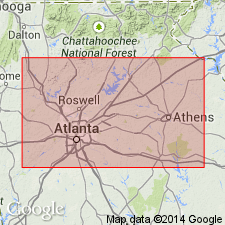
- Usage in publication:
-
- Crider Gneiss*
- Modifications:
-
- Named
- Dominant lithology:
-
- Gneiss
- AAPG geologic province:
-
- Piedmont-Blue Ridge province
Summary:
Named as part of the allochthonous assemblage. Named for Crider Creek, New Georgia 7.5-min quad, northwestern GA. Underlies a belt 5 km long northwest of Villa Rica, GA. Complete section not exposed. Saprolite outcrops, shown in figure 8, form a composite type section. Commonly found as residual boulders where deeply weathered. Consists of gray to nearly white, massive to slabby, medium- to coarse-grained, poorly to well-foliated biotite-muscovite-quartz-plagioclase gneiss that is locally contorted and generally weathers to light-tan to dark-yellowish-tan soil containing corestones of gneiss. Presence of muscovite in excess of biotite is one feature that distinguishes it from Stonewall Gneiss. Similar to some calc-silicate gneisses in Wahoo Creek Formation. Age is Late Proterozoic(?) to Middle Ordovician(?) based on overall age of allochthonous assemblage. Report includes geologic map and correlation chart.
Source: GNU records (USGS DDS-6; Reston GNULEX).
For more information, please contact Nancy Stamm, Geologic Names Committee Secretary.
Asterisk (*) indicates published by U.S. Geological Survey authors.
"No current usage" (†) implies that a name has been abandoned or has fallen into disuse. Former usage and, if known, replacement name given in parentheses ( ).
Slash (/) indicates name conflicts with nomenclatural guidelines (CSN, 1933; ACSN, 1961, 1970; NACSN, 1983, 2005, 2021). May be explained within brackets ([ ]).

